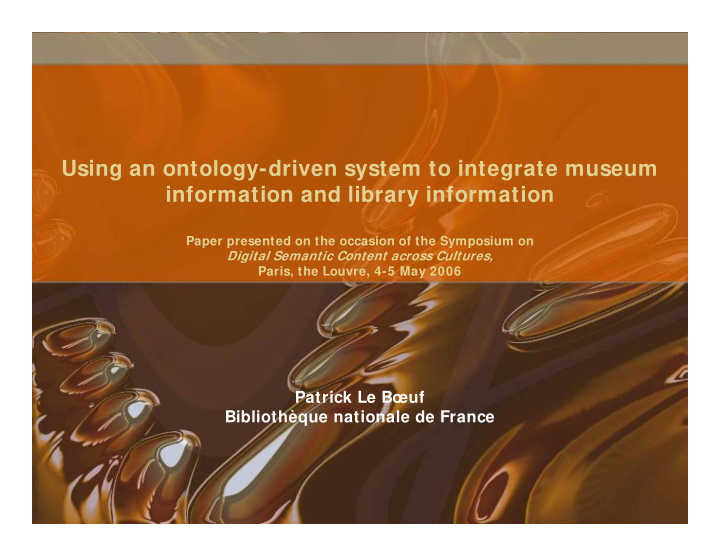



Using an ontology-driven system to integrate museum information and library information Paper presented on the occasion of the Symposium on Digital Semantic Content across Cultures, Paris, the Louvre, 4-5 May 2006 Patrick Le Bœuf Bibliothèque nationale de France
1. I nfodiversity • “The nice thing about standards is that there are so many to choose from…” • However, “infodiversity is good” (Tony Gill) for cultural heritage information • … Would end-users agree?... • Our challenge: – To preserve institutions’ commitment in the information they produce about their collections – and to meet end-users’ information needs (integrated information, logical inferences from information stored in heterogeneous databases) 2
I ntegrated information: a wonderful dream… Books about this object Other objects of same Reference cultural context tools that mention it Other objects of same technique Books about its cultural context, about its technique, about this type of objects Other objects of same type Books about the subject it depicts Other objects depicting the same subject Related literary works URLs for Reproduc- Audio-visual digitisa- tions of it materials about it tions of it 3
2. The SCULPTEUR Project • European-funded (2002-2005) • Partners: C2RMF, The National Gallery (UK), Victoria & Albert Museum, Galleria degli Uffizi… • Technical infrastructure: University of Southampton (UK) • Produced the “Concept Browser”: a graphic interface to query heterogeneous museum databases • I nformation is integrated through mapping to a common ontology : CI DOC CRM 4
3. The CI DOC CRM • CRM = “Conceptual Reference Model” • Developed by I COM CI DOC from 1996 on • Leader = Martin Doerr • I SO standard 21127 • CRM = a basis for data exchange and for building integrated query tools 5
3. The CI DOC CRM • 81 classes, 132 properties • Key concepts = Actor Involving Involving Appellation Appellation what? whom? Physical Actor Conceptual What Thing Object happened? Event Of what Time-Span Place Type ? When? Where? Time Place Appellation Appellation 6
The CI DOC CRM in the Concept Browser http://www.sculpteur.ecs.soton.ac.uk/software/concept/doc/ 7
The CI DOC CRM in the Concept Browser • Simplified ontology, in the mSpaces browser: Addis, M., et al., New Ways to Search, Navigate and Use Multimedia Museum Collections over the Web, Figure 4, in J. Trant and D. Bearman (eds.). Museums and the Web 2005: Proceedings , Toronto: Archives & Museum Informatics, published March 31, 2005 at http://www.archimuse.com/mw2005/papers/addis/addis.fig4.html 8
4. Bibliographic information • CI DOC CRM focuses on museum information • = > Possible to use it for bibliographic information as well??? – Museum info: mainly about “unique” physical objects – Bibliographic info: mainly about “publications”, an abstract notion instantiated in holdings 9
4. Bibliographic information • I s there an ontology for bibliographic information, comparable to CI DOC CRM? – Not an “ontology”, but a conceptual model: FRBR (Functional Requirements for Bibliographic Records) – Developed by I FLA, published in 1998 – Current work to align it on CI DOC CRM – Planned to have a harmonised ontology covering both FRBR’s scope and CI DOC CRM’s scope – Not yet available, therefore not available at the time the Concept Browser was being developed… 10
4. Bibliographic information • Eventually, mapping UNI MARC Bibliographic format to CI DOC CRM proved feasible… • … but time-consuming… (2004-April 2006!) • The SCULPTEUR Project is closed now… I s it too late? • However, we need to check the mapping and the ability of the Concept Browser to integrate museum and library information 11
5. Possible next steps • Test the integration of bibliographic records with museum information in th Concept Browser • ? Map thesauri, classification schemes, subject authority files to the CI DOC CRM – Objective: allow end-users e.g. to navigate from studies on a technique to artefacts produced by that technique Other objects Books about of same that technique technique 12
Recommend
More recommend